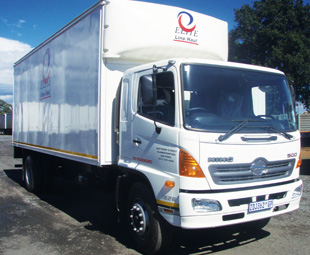New name; same reliability

This month VIC OLIVER puts the Hino 500 1626 through its paces and finds out if the new model lives up to Hino’s solid reputation.
For those who don’t know, the new Hino 500 1626 extra-long wheelbase replaces the previous Hino 500 15-258 model. The change is in nomenclature only: the 1626’s specifications are identical to those of the 15-258 and Hino has only made the change to bring its range in line with international model identifications. The new names make it far easier to instantly discern the truck’s gross vehicle rating (GVR) and horsepower which, in this case, are 16 000 kg and 260 hp (191 kW) respectively.
The 1626 offers a legal payload of 7 550 kg; and with a gross combination mass (GCM) of 24 000 kg it can also pull a trailer. This impressive payload is the result of a low overall tare mass of 7 750 kg (which includes the 7 400 mm van body), thanks to the single skin weight-saving chassis frame fitted to all new Hino 500s.
I drove the truck a total distance of 138 km along the N12 towards Witbank and back to our starting point at Elandsfontein.
Getting started
Before I could actually get the vehicle onto the road to begin the test run, I had to manoeuvre it out of a congested yard. But, thanks to power steering, a good turning circle and well-designed mirrors, manoeuvring this long-wheelbase unit is surprisingly easy – an important feature for a freight distribution carrier chassis such as the 1626.
In addition, front and rear semi-elliptical multi-leaf spring suspension with single acting shock absorbers on the front axle and an auxiliary spring pack on the rear give the vehicle a smooth ride in both loaded and unloaded modes.
Full air brakes are a bonus feature on a truck of this size and a great benefit if the vehicle is going to be used to pull a trailer; particularly if a tag axle is fitted to the truck, as it is far easier to marry an air braking system to a tag axle than to an hydraulic brake system.
As an optional extra, a trailer test facility can be incorporated into the handbrake, which in my opinion is a nice-to-have safety feature enabling a driver to test the trailer brakes during his pre-trip inspection in some trailer applications.
The engine dipstick and all the fluid levels can be checked without having to tilt the cab. However, should it become necessary to do so, this is easily achieved by one person. A good safety lock is fitted, which is automatically activated when the cab reaches its full tilt position. A second safety locking device is also fitted to lock the cab in the down position.
A single-sleeper bunk, complete with a mattress and curtains, comes standard with this vehicle enabling drivers to rest during a long trip. However, the sleeper bunk cannot be classed as a full sleeper because it is very narrow with a width of only 500 mm.
Although the noise level inside the cab while travelling is good, the gentle throb of the diesel engine can be heard. Some of the models competing in this segment of the market definitely offer better sound-proofing.
There is only one cab entrance step fitted on both left- and right-hand sides of the vehicle, making entrance and exit difficult and possibly even dangerous for driver and passenger. In addition, the docket holders fitted on both doors are too small to hold an A4-size document or clipboard. This means that a driver or passenger needing to exit the cab with an A4-size docket has to climb down with the document or clipboard in one hand, leaving only one hand available for holding the cab grab-handle. This could result in a driver or passenger falling from the cab.
On the road
After just a few minutes behind the wheel of the 1626, it becomes clear that the Hino J08C-TT turbo-intercooled engine offers excellent power and torque ratios. The engine offers low-down torque just above idle speed, while at 1 500 rpm it is producing its full 739 Nm of torque.
Good low-down torque means that a driver is able to start the vehicle moving without revving the engine, which in turn will prolong the life of the clutch and driveline components. The torque curve of this particular engine is also very flat, offering drivers a wide range of full torque and enabling the truck to be comfortably driven within the green economical driving band without excessive gear changes.
The Euro 2 engine meets current environmental emission standards and – thanks to radial tyres fitted all round, the modern turbo-intercooled engine, well-matched drive train and good cab design – fuel consumption is also excellent. During the test run we used 18.1 l/100 km, although it must be noted that the vehicle was not loaded and I drove within the green economical driving band throughout the trip.
Gear changing and clutch operation were both smooth. The 1626 has a Hino MF06 S Synchromesh six-speed gearbox which is well matched to the engine, while the 380 mm-diameter single clutch plate should give the operator excellent clutch life.
Based on this road test, I believe the Hino 1626 will be a strong contender in the South African truck market’s freight distribution carrier chassis segment.
Published by
Focus on Transport
focusmagsa




